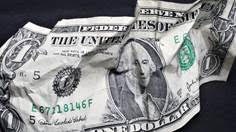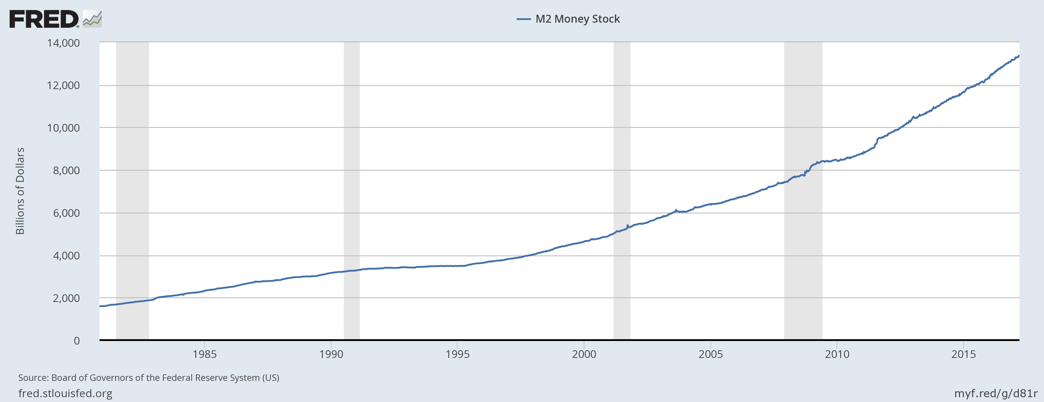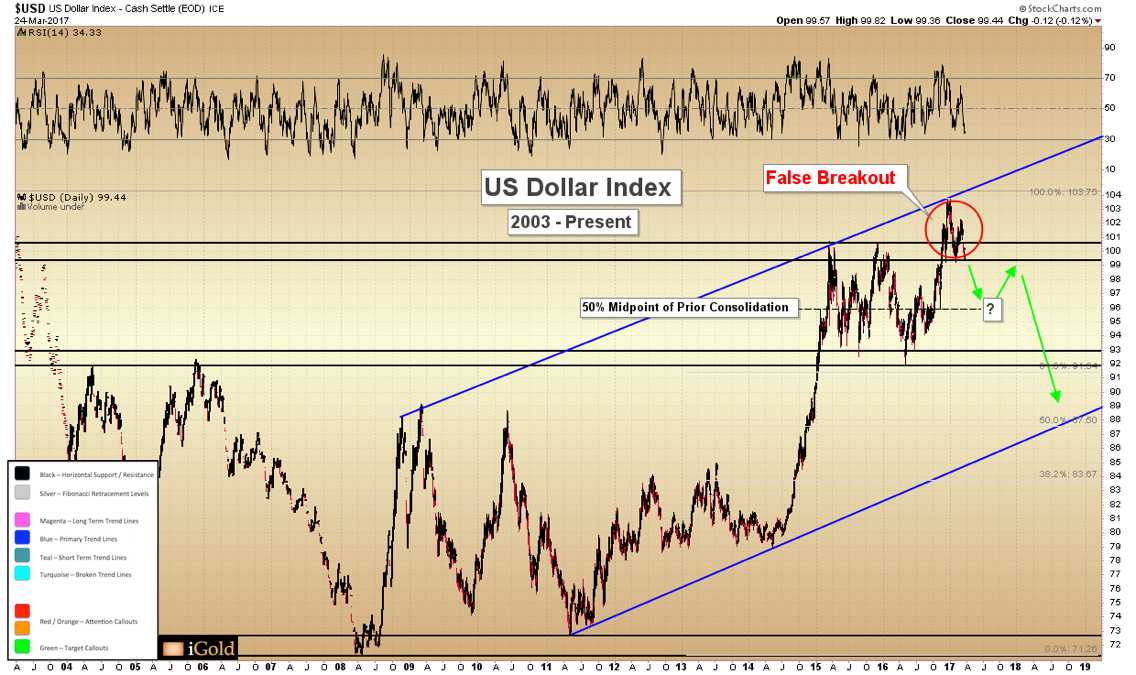US Dollar On The Verge Of A Major Reversal (Part I)

The US dollar is on the verge of a major reversal lower, which will have important ramifications for world markets: most notably currency cross-pairs, commodities and precious metals.
Many readers will already know the poor fundamentals underlying the US currency: unsustainable debt levels in the United States, trillions in unfunded liabilities due for the next generation of Social Security and Medicare recipients, ceaseless unwinnable wars, and a central bank that continues to debase the money supply.
For example, M2 is the broadest figure of US money supply, and includes physical cash and coins, checking accounts, savings accounts, and money market accounts. It is the broadest measure of money that is currently published by the Federal Reserve. Below we can see the continued creation of new money by the Fed over the last generation:
Fundamentals Do Not Matter – Psychology Does
Yet ironically, the consistent debasement of currency as shown above does not tell us anything about what might happen to the value of the US dollar over the short or intermediate timeframe. For example, as the dollar continued to be printed from 2008 - 2017, it actually rose in value versus foreign currencies. Further, the things we would expect to rise during periods of monetary debasement actually fell in value, with gold losing 45% from 2011 – 2015, and silver losing over 70% -- all while the currency continued to be debased.
For a precious metals investor, the long-term fundamentals simply do not matter over any usable timeframe to determine a successful holding period. If a central bank debases a currency but the population remains oblivious, these fundamentals can continue for many years without any increase in the value of gold or silver.
If the fundamentals do not move the markets, then what does?
Market Psychology.
Market psychology is the key to the entire precious metals investment thesis. When will a critical mass awaken to the continued debasement of the currency and look to divert a portion of their savings out of US dollars and into precious metals?
A shift in consciousness by a sizeable portion of western citizens is what is needed to cause a major advance in gold prices.
It won’t happen at a single moment, but the good news is that this change in market psychology will be observable on the charts.
The first hint of such a new psychology will be visible in the currency markets – in the form of a reversal pattern lower for the US dollar.
A reversal pattern is exactly what we have been monitoring in the US dollar for the last four months – and it is gaining momentum as this article goes to press.
We now turn to the charts of the US dollar in order to observe what may be the beginning of this shift in psychology away from the world’s reserve currency and into precious metals – the beginning of a major opportunity ahead.
US Dollar
Despite the rampant inflation as shown by the M2 money supply growth over the last decade, the US dollar has been rising in value versus a basket of world currencies since 2008. This marks a nearly 9-year bull market as can be seen below by the broad parallel blue trendlines.
The strongest portion of the dollar’s advance came from mid-2014 to mid-2015, as the US currency rose from 79 on the index to over 100.
From 2015 – 2016 the US dollar consolidated between 100 and 92, a range defined by the black horizontal lines on the upper portion of the chart.
All things considered, in technical analysis a consolidation of this nature is typically considered to be a continuation pattern in the direction of the prior trend. In this case, the preceding move was higher, and indeed the consolidation broke higher in November 2016 in the days following Trump’s presidential victory.
The sentiment at the time of the dollar breakout was: “Trump is going to lower taxes, boost infrastructure spending, and reduce deficits.” Fast forward a few months later and the market is starting to doubt this conclusion.
US Dollar Reverses Lower
Here is where we believe the story for the dollar is about to fool most investors and reverse lower. Let us refer to the zoomed in portion of the dollar index from 2015 - 2017, shown below:
Again, the breakout from the 2015-2016 consolidation above 100 is visible by the red callout.
The technical target for the breakout of the US dollar was 108, or roughly equivalent to the amplitude of the prior consolidation.
As mentioned in a flash update to subscribers on March 26, in the overnight hours of trading in Asia, the dollar fell below 99.5, thus negating the top support zone and triggering a Head & Shoulders top pattern highlighted in blue.
The dollar should thus fail to achieve its consolidation target of 108.
This is an extremely bearish reversal – not due to the initial target from the breakdown (95.5) – but due to the fact that it has occurred at the upper extreme range of a nearly 9-year advance.
By breaking above 100 on the index and then failing to hold this level after two retests since November (black callouts, above), the dollar has seen a false breakout after a multi-year advance. This is one of the most negative reversal patterns that we have encountered in years of studying technical analysis.
False breakouts after multi-year advances tend to reverse rapidly in the opposite direction, and then after a modest initial rebound, begin to form a new trend downward.
As precious metals tend to move opposite the dollar, an extended period of dollar weakness would set the stage for an extended rally in the precious metals over the next few years.
Short-Term Targets For The Dollar
The Head & Shoulders Top formation shown above in blue has now been triggered, breaking below 99.5 on the index. The target for this pattern is 95.5, or four points lower than the breakdown.
This target necessitates that the dollar will break the rising (dashed blue) trendline, which has defined the most recent portion of the advance since May 2016. The trendline comes in at 98.5.
Some traders will buy the test of the trendline when it occurs, so we should expect to see a short bounce at 98.5 back up to 99.5 – 100.0. However, this bounce should fail to recover the broken support zone, and the dollar should reverse lower quickly, breaking the dashed trendline and reaching the target of 95.5 within four weeks.
In Part II of this series, we will cover longer-term targets for the US dollar based on the fulfillment of the short-term targets we anticipate herein. We will also examine how this reversal might impact the value of the euro, and how precious metals are likely setting up for a significant advance as a result.
********





















